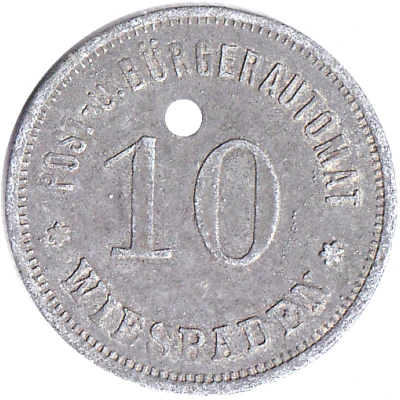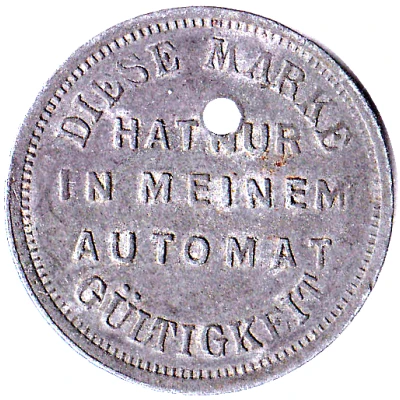


© KaterMurr (CC BY-NC-SA)
10 Pfennigs - Wiesbaden (Post- und Bürgerautomat) ND
| Zinc | 3.5 g | 21.3 mm |
| Issuer | City of Wiesbaden (Prussian province of Hesse-Nassau) |
|---|---|
| Type | Standard circulation coin |
| Value | 10 Pfennigs (10 Pfennige) (0.10) |
| Currency | Mark (1914-1924) |
| Composition | Zinc |
| Weight | 3.5 g |
| Diameter | 21.3 mm |
| Shape | Round with a round hole |
| Technique | Milled |
| Orientation | Medal alignment ↑↑ |
| Demonetized | Yes |
| Updated | 2024-10-04 |
| Numista | N#145061 |
|---|---|
| Rarity index | 97% |
Reverse
Script: Latin
Lettering:
DIESE MARKE
HAT NUR
IN MEINEM
AUTOMAT
GÜLTIGKEIT
Comment
Issuing authority: [Privat, Hessen-Nassau]Menzel: BBB
Interesting fact
One interesting fact about this coin is that it was minted during a time of great economic and political change in Germany. The 10 Pfennigs coin was introduced in 1924, just a few years after Germany's hyperinflation crisis, which saw the value of the German mark plummet to nearly worthless levels. The introduction of the 10 Pfennigs coin, along with other denominations of the Reichsmark, was an attempt to stabilize the German economy and restore confidence in the currency. Additionally, the coin's minting in Wiesbaden, a city in the Prussian province of Hesse-Nassau, highlights the complex history of Germany's regional currencies and the eventual unification of the country's currency under the Reichsmark.